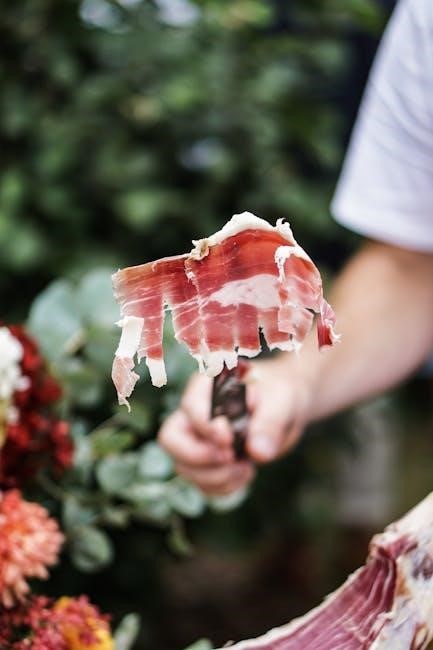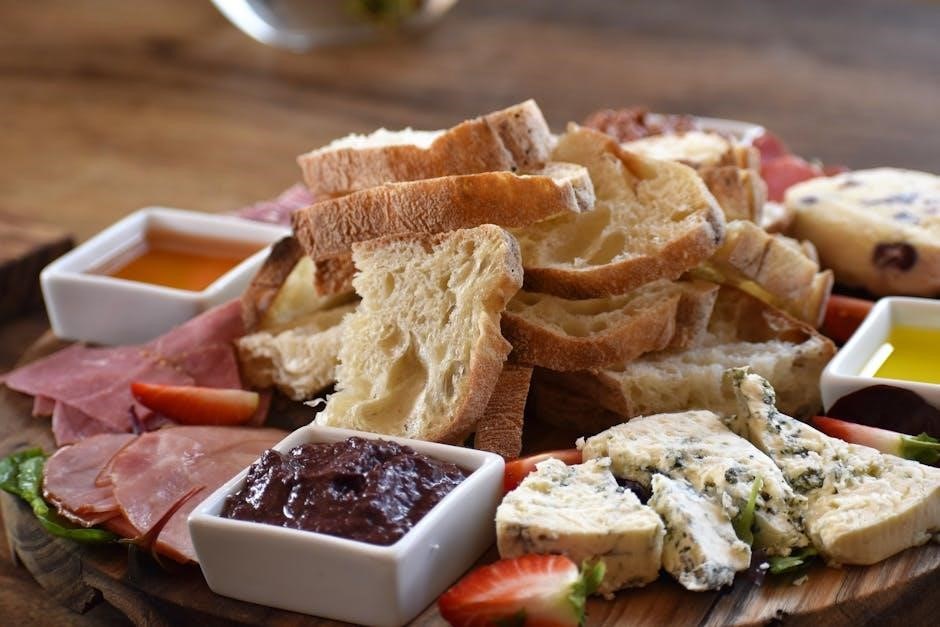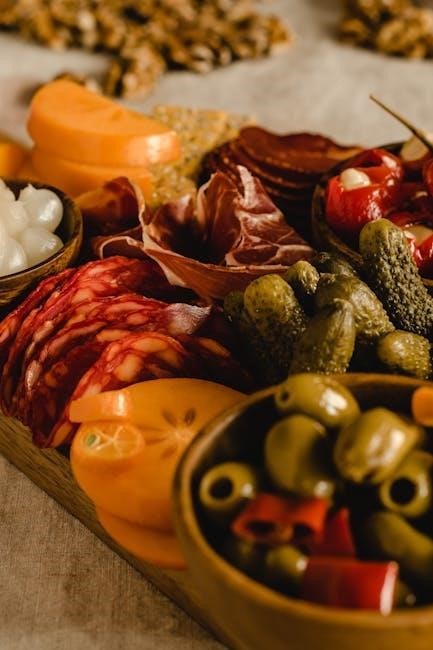Cooking ham shank is an art that transforms a tough cut into tender, flavorful meat. Perfect for slow-cooked dishes like stews or braises, it offers a budget-friendly, delicious meal option. With proper seasoning and low-and-slow cooking, ham shank becomes fall-off-the-bone tender, making it a hearty addition to any meal. Whether glazed, roasted, or simmered in a rich sauce, this versatile cut is a culinary gem worth exploring for home cooks and chefs alike.
What is a Ham Shank?
A ham shank is a portion of the pork leg, typically including the ankle bone and surrounding muscle. It is a tougher cut due to its connective tissue, but when slow-cooked, it becomes tender and flavorful. Often used in braises, stews, or roasts, the ham shank is a budget-friendly option that delivers rich, hearty results. Its bone-in structure adds depth to dishes, making it a popular choice for home cooks seeking a flavorful, comforting meal.
Popular Cooking Methods for Ham Shank
Ham shanks are best cooked using slow, moist-heat methods like braising or slow cooking to break down connective tissue. Braising involves searing the meat, then simmering it in liquid (stock or wine) on the stovetop or in the oven. Slow cooking yields tender results over 8-10 hours. Roasting is another option, where the ham shank is browned in the oven, creating a crispy exterior. Pressure cooking is ideal for shorter cooking times, achieving fall-off-the-bone tenderness quickly. These methods ensure a flavorful, hearty dish.
Why Cook Ham Shank?
Cooking ham shank is a rewarding experience that offers both flavor and value. This budget-friendly cut becomes tender and rich when properly cooked, making it ideal for hearty meals. It absorbs flavors beautifully, whether from spices, sauces, or aromatics, creating a dish that’s both satisfying and delicious. Ham shank is also versatile, suitable for comforting stews, elegant roasts, or casual weeknight dinners. It’s a great way to enjoy a home-cooked meal without breaking the bank, offering a taste of tradition and culinary creativity.

Understanding the Cut of Meat
Ham shank, from the pig’s leg, includes bone and muscle. Tough but flavorful, it’s ideal for slow cooking, yielding tender results with proper techniques.
Anatomy of the Ham Shank
The ham shank is a portion of the pig’s leg, comprising bone, muscle, and connective tissue. It is a tough cut due to its dense muscle fibers and high collagen content, which makes it ideal for slow-cooking methods. The bone adds flavor during cooking, while the surrounding meat becomes tender with proper preparation. The shank also contains layers of fat, which contribute to its rich, unctuous texture when cooked low and slow. This structure makes it perfect for braising or roasting to achieve fall-off-the-bone results.
Types of Ham Shanks
Ham shanks vary in preparation and curing methods, offering diverse flavors. Smoked ham shanks are rich and savory, while fresh ones are leaner. Cured ham shanks are seasoned with spices, adding depth. Some are pre-cooked, offering convenience, while others are raw, ideal for slow-cooking. Bone-in shanks are traditional, providing robust flavor, while boneless options are easier to portion. Each type suits different recipes, from hearty stews to glazed roasts, catering to various tastes and cooking preferences.
Choosing the Right Ham Shank
Selecting the right ham shank depends on size, freshness, and curing. Opt for a shank with a good balance of meat and fat for moisture. Smoked or cured shanks offer richer flavors, while fresh ones are leaner. Bone-in shanks provide more flavor during cooking. Consider the recipe’s needs—larger shanks suit slow-cooking, while smaller ones are ideal for glazing. Always inspect for marbling or a thin fat layer to ensure tenderness. The right choice enhances the dish’s overall texture and flavor profile, making it a satisfying meal.

Nutritional Benefits of Ham Shank
Ham shank is rich in protein, minerals, and vitamins, making it a nutritious choice. It provides iron, zinc, and B vitamins while offering leaner options for health-conscious diets.
Protein Content
Ham shank is an excellent source of high-quality protein, essential for muscle growth and repair. Each serving provides a significant amount of protein, making it ideal for meat lovers seeking a nutritious meal. The leaner cuts of ham shank are particularly beneficial for health-conscious individuals, offering a balanced mix of protein and minimal fat. This makes it a great option for those looking to boost their protein intake without compromising on flavor or nutritional value.
Minerals and Vitamins
Ham shank is rich in essential minerals like zinc, phosphorus, and selenium, which support immune function and overall health. It also contains B vitamins, particularly vitamin B12, crucial for energy metabolism and nerve health. The slow-cooking process helps retain these nutrients, making ham shank a nutritious choice. Pairing it with vegetables enhances its vitamin profile, offering a balanced meal. Opting for leaner cuts further reduces fat content, making it a healthier, nutrient-rich option for hearty dishes.
Low-Fat Options
Cooking ham shank can be adapted to suit low-fat diets by trimming excess fat and selecting leaner cuts. Baking or braising without added oils reduces fat content. Using herbs and spices for flavor instead of fatty glazes keeps the dish healthy. Pairing the shank with vegetables or whole grains balances the meal without extra fat. This approach preserves the meat’s tenderness while offering a guilt-free, flavorful option for health-conscious cooks seeking hearty, satisfying recipes.

Tools and Equipment Needed
A Dutch oven, braising pot, or large roasting pan is essential for slow-cooking ham shank. A stovetop or oven ensures even heat distribution. Tongs, slotted spoons, and sharp knives are handy for preparation and serving. Stockpots and oven-safe skillets are also useful for various cooking methods. Proper tools enhance the cooking process, ensuring tender and flavorful results.
Pots and Pans
A large Dutch oven or braising pot is ideal for slow-cooking ham shank, as it distributes heat evenly and retains moisture. A heavy-bottomed roasting pan is perfect for oven roasting, while a deep stockpot works well for simmering. Oven-safe skillets are versatile for stovetop searing and finishing in the oven. Ensure pots and pans are sturdy and large enough to accommodate the ham shank comfortably, allowing for even cooking and preventing overcrowding.
Oven and Stovetop Requirements
Preheat your oven to 325-350°F (165-175°C) for slow-cooking or roasting ham shank. On the stovetop, use medium heat to sear the ham shank before braising. A Dutch oven or heavy-bottomed pot is essential for even heat distribution. Ensure your cookware is oven-safe and large enough to fit the ham shank comfortably. Proper temperature control and even heating are crucial for tenderizing the meat and achieving a rich, flavorful dish. Always preheat the oven and prepare your stovetop setup before starting the cooking process.
Other Essential Tools
Additional tools like aluminum foil for wrapping, kitchen shears for trimming excess fat, and a meat thermometer ensure even cooking. Tongs or a spatula are ideal for handling the ham shank. A roasting rack elevates the meat, promoting air circulation. For glazing, a basting brush is indispensable; These tools enhance your cooking experience, helping you achieve tender, flavorful results. They are must-haves for any ham shank recipe, ensuring precision and ease throughout the cooking process.

Ingredients for Cooking Ham Shank
Essential ingredients include ham shank, flour, chile powder, kosher salt, chicken stock, onions, garlic, butter, olive oil, and brown sugar for glazing. These enhance flavor and texture.
Meat and Marinades
Ham shank is the star, available smoked or fresh. Marinades often include flour, chile powder, garlic, and spices to tenderize and flavor the meat. Honey, brown sugar, or glazes add a sweet, caramelized crust. Marinating ensures deep flavor penetration, while braising liquids like stock or wine enhance tenderness. Proper seasoning with salt and pepper is essential. Marinating overnight or during cooking infuses rich, savory notes, making the ham shank a delicious centerpiece for hearty meals.
Vegetables and Aromatics
Onions, carrots, celery, and garlic are essential aromatics for ham shank dishes, adding depth and complexity. Sautéing these vegetables before adding the ham creates a flavorful base. Root vegetables like potatoes and parsnips are often included for texture and sweetness. Herbs such as bay leaves, thyme, and rosemary enhance the dish, while fresh garlic and onions provide a savory foundation. These ingredients meld together during slow cooking, infusing the ham with rich, aromatic flavors that elevate the meal to a hearty, satisfying experience.
Spices and Seasonings
Spices and seasonings are crucial for enhancing the flavor of ham shank. Common choices include bay leaves, cinnamon, juniper berries, and thyme, which add aromatic warmth. Black pepper and kosher salt are staples for seasoning, while paprika and chile powder introduce a smoky, spicy note. Herbs like rosemary and garlic infuse a savory depth, balancing the richness of the meat. These ingredients create a harmonious blend that elevates the dish, transforming the ham shank into a flavorful, aromatic masterpiece perfect for hearty meals.

Cooking Methods
Cooking ham shank involves methods like braising, roasting, slow-cooking, and pressure-cooking, each offering unique flavors and tender results. These techniques ensure a delicious, fall-off-the-bone dining experience.
Braising
Braising ham shank is a popular method that involves searing the meat and slow-cooking it in liquid, such as stock or wine, on low heat. This technique breaks down the connective tissue, resulting in tender, flavorful meat. Brown sugar and spices are often used for glazing, enhancing the dish’s richness. Braising can be done in a Dutch oven or on the stovetop, ensuring a hearty, comforting meal perfect for special occasions or cozy gatherings.
Roasting
Roasting ham shank brings out its rich, caramelized flavors. Preheat the oven to 325°F, trim excess fat, and place the ham in a roasting pan. Brush with glaze or seasonings, ensuring even coverage. Roast for about 20 minutes per pound, basting occasionally to keep the meat moist. Tent with foil if browning too quickly. The result is a crispy exterior with tender, juicy meat inside. This method is ideal for achieving a flavorful, visually appealing dish perfect for any occasion.
Slow Cooking
Slow cooking ham shank is a perfect method for tender, flavorful results. Place the shank in a Dutch oven or slow cooker with aromatic vegetables and seasonings. Cook on low heat for 8-10 hours, allowing the connective tissues to break down. This method ensures the meat becomes fall-off-the-bone tender. Ideal for hands-off preparation, slow cooking transforms the ham shank into a hearty, comforting dish. Pair it with mashed potatoes, polenta, or roasted vegetables for a satisfying meal.
Pressure Cooking
Pressure cooking ham shank is a time-saving method that delivers tender results quickly. Brown the shank in a pan, then transfer it to a pressure cooker with chicken stock, spices, and seasonings. Cook on high pressure for 45 minutes, allowing natural pressure release. This method breaks down connective tissues efficiently, yielding flavorful, fall-off-the-bone meat. Perfect for busy cooks, pressure cooking preserves the ham shank’s rich flavor while significantly reducing cooking time compared to traditional braising or slow cooking methods.

Flavor Enhancements
Enhance ham shank’s richness with glazes, marinades, or spices. Honey, red wine, and aromatic herbs like bay leaves and cinnamon add depth, transforming it into a flavorful, savory dish.
Marinades and Rubs
Marinades and rubs elevate ham shank’s flavor, ensuring tender, aromatic results. Common ingredients include honey, olive oil, garlic, and spices like paprika or cinnamon. Coating the shank with a spice rub or marinating it overnight enhances texture and taste. For a crispy exterior, some recipes suggest dusting with flour before searing. Acidic components like vinegar or citrus in marinades help break down connective tissues, while herbs add complexity. These preparations are key to achieving a fall-off-the-bone, flavorful dish.
Glazes and Sauces
Glazes and sauces add a rich, tangy, or sweet dimension to ham shank dishes. Honey, brown sugar, and mustard are common glaze ingredients, while red wine, broth, or miso create savory braising liquids. Some recipes feature fruit-based sauces, like cherry or apple, for a sweet contrast. Glazes are often brushed on during cooking to caramelize and enhance flavor. Sauces can be simmered with the ham shank, infusing it with deep, complex notes. These finishes elevate the dish, balancing the hearty, meaty texture with vibrant flavors.

Herbs and Spices
Herbs and spices play a crucial role in enhancing the flavor of ham shank dishes. Bay leaves, juniper berries, and cinnamon are popular choices for adding aromatic depth. Smoked paprika or chili flakes can introduce a smoky, spicy note, while thyme and rosemary provide earthy undertones. These seasonings are often used in rubs or added to braising liquids, infusing the meat with complex flavors during slow cooking. Experimenting with different spice combinations can create unique and memorable taste profiles for your ham shank recipes.

Serving Suggestions
Serve ham shank with mashed potatoes, polenta, or roasted vegetables for a hearty meal. Pair with steamed greens or corn for a balanced plate.
Side Dishes
Pair ham shank with classic mashed potatoes, creamy polenta, or roasted root vegetables like carrots and Brussels sprouts. Steamed greens or sautéed spinach add a refreshing contrast. For a hearty meal, serve with garlic asparagus, corn on the cob, or a crisp salad. Braised red cabbage or sweet potato wedges also complement the rich flavors of the ham. These sides balance the bold, savory taste of the shank, creating a well-rounded and satisfying dining experience.
Garnishes and Presentation
Elevate your ham shank dish with fresh herbs like parsley or rosemary for a vibrant finish. A citrus wedge, such as orange or lemon, adds a pop of color and freshness. Drizzle with a glaze or sauce for a glossy appearance. Garnish with edible flowers or microgreens for a modern touch. Serve with roasted vegetables or mashed potatoes to create a visually appealing meal. These simple yet elegant presentation ideas enhance the overall dining experience and make the dish standout.
Meal Pairing Ideas
Pair your tender ham shank with creamy mashed potatoes, roasted root vegetables, or a hearty grain like polenta or risotto. For a lighter option, serve alongside a crisp green salad or steamed asparagus. Braised ham shank also complements rich soups or stews, creating a satisfying meal. Experiment with pairing it with earthy mushrooms or caramelized onions for added depth. These combinations enhance the dish’s robust flavors, ensuring a well-rounded and memorable dining experience.

Common Mistakes to Avoid
Avoid overcooking, as it dries the meat. Don’t skip proper seasoning, as it enhances flavor; Ensure the ham shank rests adequately for juicy results.
Overcooking
Overcooking ham shank is a common mistake that results in dry, tough meat. This occurs when the meat is exposed to high heat for too long or cooked beyond the recommended time. To prevent this, use a meat thermometer to monitor internal temperature and ensure the shank is tender but not overly dry. Slow cooking methods, like braising or pressure cooking, help retain moisture and prevent overcooking. Always allow the meat to rest after cooking to redistribute juices and maintain tenderness.
Underseasoning
Underseasoning is a common pitfall when cooking ham shank, leading to a bland and uninspiring dish. To avoid this, season the meat generously before cooking, using a mix of spices, herbs, and marinades. Allow the ham shank to sit for a while after seasoning to let the flavors penetrate deeply. During cooking, taste and adjust the seasoning as needed. Proper seasoning enhances the natural flavors of the ham shank, ensuring a rich and satisfying meal without overpowering the dish with saltiness.
Improper Resting
Improper resting is a mistake that can ruin a perfectly cooked ham shank. After cooking, it’s crucial to let the meat rest to allow juices to redistribute, ensuring tenderness. Cutting into the ham shank too soon can cause the juices to escape, leaving the meat dry and tough. Always let the ham rest for at least 10-15 minutes before carving or serving. This simple step ensures a moist, flavorful dish and prevents the meat from becoming unappetizingly dry.
Cooking ham shank offers a flavorful and hearty meal with its rich, tender results. Experiment with various methods and seasonings to elevate this versatile cut into a culinary masterpiece.
Final Tips
For a perfect ham shank, ensure thorough seasoning and slow cooking to achieve tender results. Use a Dutch oven or heavy pot for even heat distribution. Rest the meat before serving to retain juices. Experiment with glazes or sauces during the last 20 minutes of cooking for added flavor. Pair with hearty sides like mashed potatoes or risotto to complement the dish. Don’t rush the process—patience yields the best outcome. Elevate your meal with creativity and enjoy the rich, satisfying flavors of ham shank.
Encouragement to Experiment
Don’t be afraid to get creative with ham shank! Try pairing it with unexpected flavors like miso, honey, or spicy sauces for a unique twist. Experiment with different cooking liquids, such as red wine, beer, or stock, to enhance depth. Incorporate global inspirations, like Moroccan spices or Korean chili flakes, for a bold twist. Remember, ham shank is versatile, so feel free to adapt recipes to your taste. The key to mastering it is embracing experimentation and having fun with the process!
